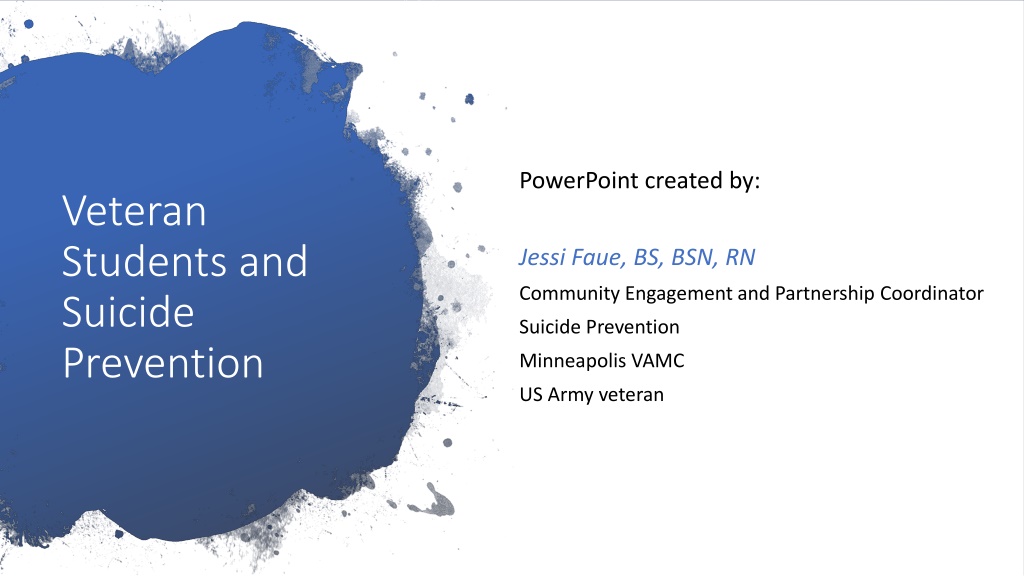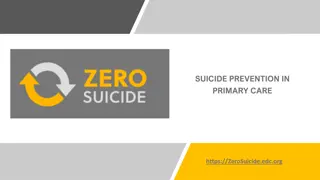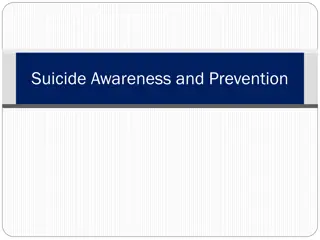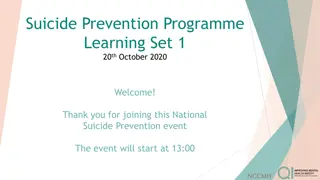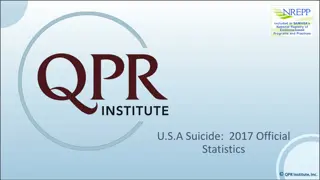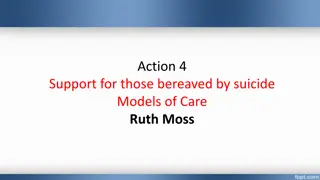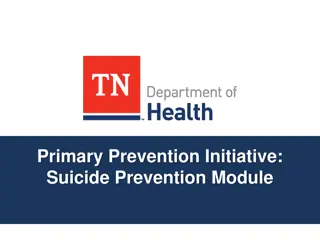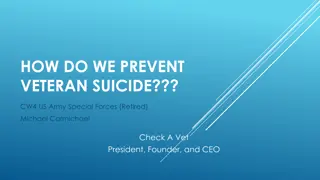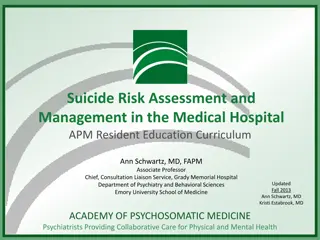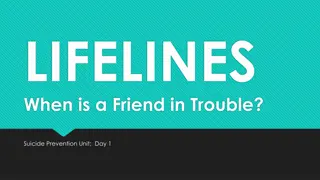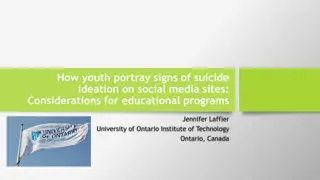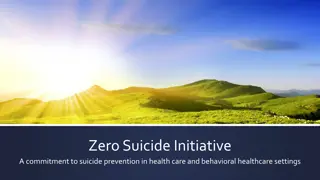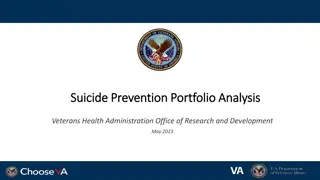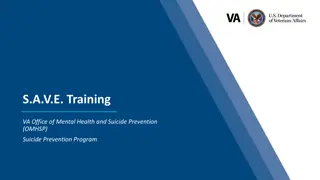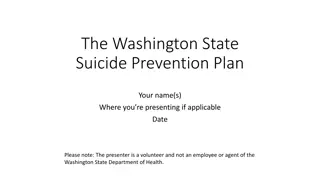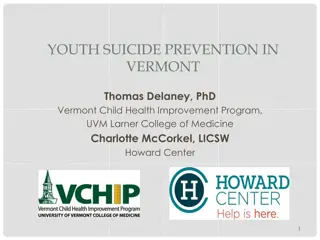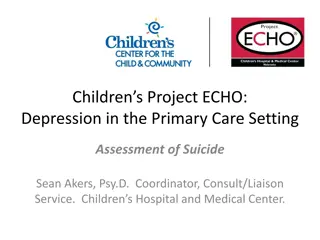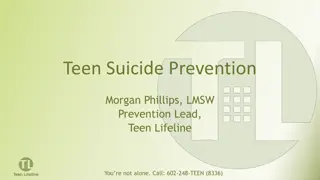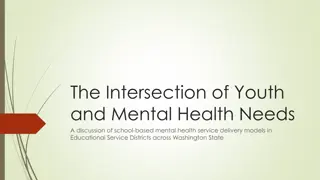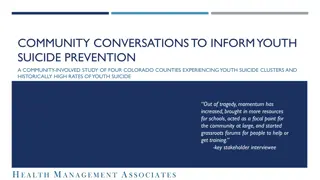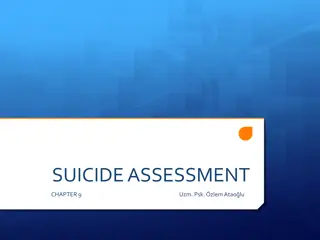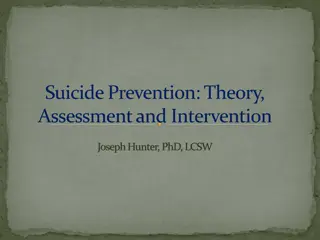Veteran Suicide Prevention Efforts in Minnesota
In Minnesota, there is a significant population of veterans facing challenges related to suicide risk, disability compensation, unemployment, and homelessness. This presentation sheds light on the statistics and demographics of veterans in Minnesota, emphasizing the importance of suicide prevention efforts and public health approaches. It highlights the concerning number of veteran suicides and provides valuable insights into risk factors, warning signs, and preventive measures that can be taken to address this critical issue.
Download Presentation

Please find below an Image/Link to download the presentation.
The content on the website is provided AS IS for your information and personal use only. It may not be sold, licensed, or shared on other websites without obtaining consent from the author. Download presentation by click this link. If you encounter any issues during the download, it is possible that the publisher has removed the file from their server.
E N D
Presentation Transcript
PowerPoint created by: Veteran Students and Suicide Prevention Jessi Faue, BS, BSN, RN Community Engagement and Partnership Coordinator Suicide Prevention Minneapolis VAMC US Army veteran
MN Veteran Population Veteran Student Population National Suicide Statistics Objectives 10 Things You Can Do to Prevent Veteran Suicide Warning Signs/Risk Factors/Protective Factors Public Health Approach S.A.V.E.
Nationally, there is around 22 million Veterans Minnesota is home for about 367,000 Veterans MN Veteran Population 66,000 have been discharged from active duty post 9/11 Of that 66,000, 43,000 have served in a combat zone
As of Sept 2014, 26,000 Female Veterans live in Minnesota In 2016, 297 Veterans identified as being homeless MN Veteran Population 23.8 percent of Veterans in Minnesota receive disability compensation. Many Veterans students have disability ratings. Gulf war Veterans carry more disability than any era. 4.9 percent of Veterans are unemployed in Minnesota
Vietnam Veterans make up largest population at 36% Gulf War and Post 9/11 Veterans make up 15-16% MN Veteran Population More than 12% of Veterans remain in rural and Northern MN More than 56,000 Veterans are in Hennepin County
Veterans Statistics in Minnesota
Nationally, suicide is the 10th leading cause of death. Suicide Statistics In 2016, 745 suicides were reported in Minnesota. 103 were Veterans. On average, 20 Veterans die by suicide every day 14 Veterans are not engaged in VHA care
Veteran Suicide 18% of all deaths by suicide among U.S. adults were Veterans Veterans are more likely than the general population to use firearms as a means for suicide On average, there are 764 suicide attempts per month among Veterans receiving recent VA health care services 25% of Veterans who died by suicide had a history of previous suicide attempts
73%-80% of Student Veterans are male, 21-27% are female. Only 15% of Student Veterans are of traditional age for college students. Most are between the ages 24-40 Veteran College Students 47% of Student Veterans have children. 47.3% of Student Veterans are married. 62% of Student Veterans are first generation students.
1. Validate the Veterans experience and show compassion. Crisis provides an opportunity to help people and give them hope. Suicide is preventable. Talk openly about suicide. 10 Things You Can Do to Prevent Veteran Suicide
10 Things You Can Do to Prevent Veteran Suicide 2. Recognize warning signs of suicidal thinking. Many Veterans may not show any signs of intent to harm themselves before doing so, but some actions can be signs that they need help.
3. Ask the question: Are you having thoughts of suicide? Many people fear that asking about suicide puts people more at risk. This is not true. By asking if someone is having thoughts of suicide or has hurt himself or herself, you are giving the person in need an opportunity to open up and share his or her feelings. 10 Things You Can Do to Prevent Veteran Suicide
4.Means do matter: Know how to safely store firearms in your home. Most Veterans who die by suicide use firearms. For someone in crisis, a locked firearm can mean the difference between a life saved and a tragic outcome. Though many Veterans are well-versed in gun safety, all Veterans and their families should understand how to properly handle and store firearms in the home. 10 Things You Can Do to Prevent Veteran Suicide
5. Encourage treatment and expedite getting help. Reassure the Veteran that help is available. Show compassion. Be honest; there are no quick answers. Treatment works. Sobriety is possible. Don t keep the Veteran s suicidal behavior a secret. Do not leave him or her alone. Take the Veteran to a local walk-in crisis center or call the county crisis line. Try to get the person to seek immediate help from the nearest hospital emergency room, or call 911. Once you have gotten the Veteran to seek help, reach out to them to show that you care. 10 Things You Can Do to Prevent Veteran Suicide Emotional crisis can affect us all; support goes a long way.
10 Things You Can Do to Prevent Veteran Suicide 6. Promote Veteran employment: Help transition Servicemembers to civilian life. Transitioning back to civilian life when leaving the military can be incredibly challenging. Those recently transitioning out of the military have a higher risk for suicide.
10 Things You Can Do to Prevent Veteran Suicide 7. She also served: Recognizing and connecting with women Veterans. Women Veterans make up a growing segment of our community. Women Veterans have a significantly higher suicide risk than their non- Veteran civilian counterparts: Adjusting for differences in age, risk for suicide is 2.4 times higher among female Veterans when compared with U.S. civilian adult females.
8. Connect Veterans to each other and to service. Veterans who have served their country have a range of skills and values that can benefit their communities. Encourage members of your community to host service days or other opportunities for Veterans to support fellow Veterans, Servicemembers, and the community at large. 10 Things You Can Do to Prevent Veteran Suicide
10 Things You Can Do to Prevent Veteran Suicide 9. Get technical: Using technology to reach Veterans and enhance connectedness. Technology is advancing quickly, and we are now able to promote public health initiatives and provide resources to Veterans in need by using online platforms.
10 Things You Can Do to Prevent Veteran Suicide 10. Treatment works: Promoting substance misuse treatment and mental health recovery through community events. Many communities are unaware of the resources they already have to help people who are facing an emotional crisis or substance use problems.
Deployments to hostile environments Frequent deployments Length of deployments Physical and/or sexual assault while in the service (not limited to women) Veteran Warning Signs/Risk Factors Exposure to extreme stress and death Service related injury/pain Difficulty with readjustment, home-school-work- balance Lack of social support Lack of effective coping skills Familiarity with weapons Negative stigma
Warning Signs Appearing sad or depressed most of the time Having trouble sleeping and eating, or showing loss of interest, which doesn t go away or continues to get worse Feeling anxious, agitated, or unable to sleep Neglecting personal welfare
Warning Signs Deteriorating physical appearance Withdrawing from friends, family, and society, or sleeping all the time Losing interest in hobbies, work, school, or other things one used to care about
Frequent and dramatic mood changes Expressing feelings of excessive guilt or shame Feelings of failure or decreased performance Warning Signs Feeling that life is not worth living; having no sense of purpose in life Talking about feeling trapped, like there is no way out of a situation Feelings of desperation, and saying that there s no solution to their problem
Threatening to hurt or kill self I wish I would never wake up Verbal and Non Verbal Warning Signs Looking for ways to self harm They would be better of without me Seeking access to means (pills, weapons, or other means) Who cares if I am dead anyway? This will be over soon Talking or writing about death, dying, or suicide
Performing poorly at work or school Doing risky things, such as driving fast or running red lights Acting recklessly or engaging in risky activities seemingly without thinking Suicidal Behaviors Giving away prized possessions Putting affairs in order, tying up loose ends, or making out a will Showing violent behavior, such as punching holes in walls, getting into fights, or engaging in self- destructive violence Seeking access to firearms, pills, or other means of harming oneself Feeling rage or uncontrolled anger or seeking revenge
Risk factors are characteristics associated with a greater likelihood of suicidal behaviors. Some risk factors for suicide include: Protective factors can help offset risk factors. These are characteristics associated with a lesser likelihood of suicidal behaviors. Some protective factors for suicide include: Veteran Suicide A prior suicide attempt Mental health conditions Stressful life events such as divorce, job loss, or the death of a loved one Availability of lethal means Positive coping skills Having reasons for living or a sense of purpose in life Feeling connected to other people Access to mental health care
Validating Veterans experiences as unique Asking about Suicide or Suicidal thoughts Engaging Veterans in the Classroom Acknowledge unique needs, i.e. extra test time Know your resources for encouraging or escorting to help
Starting the Conversation Starting the Conversation How are your thoughts today? Sometimes when people are going through (stressor) they have negative thoughts. Are you having thoughts of suicide or dying? How is your mental wellness today?
How do you look when talking about hard topics? What are your views on Suicide? Starting the Conversation Emotions are normal but staying calm is key. You might be the only person on the receiving end of this information. How would you feel if someone told you they were suicidal?
Changing the Language Replacing commit suicide to died by suicide. Not using suicide or death as common jargon. Encourage all to not use negative self talk, or banter around suicide and to take suicidal talk seriously. Example: No one says they would rather get cancer than eat broccoli but we easily say we would rather die than eat broccoli.
Building and Engaging Community Public health is the science and art of promoting health, preventing disease, and prolonging life through the organized efforts of society. The public health approach is widely regarded as the approach that is mostly likely to produce significant and sustained reductions in suicide.
1) Primary Prevention: Focuses on preventing suicidal behavior before it occurs. 2) Whole Health: Factors beyond mental health including physical health, alcohol or substance misuse, and life events must be considered. Public Health- VA s Approach 3) Application of Data and Research: Emphasizes evidence- based approaches that can be tailored to fit the needs of Veterans in local communities. 4) Collaboration: To educate and empower diverse communities to participate in suicide prevention efforts, many different sectors need to come together and coordinate efforts.
Suicide First Aid for responding the care and compassion when encountering a person/Veteran in crisis SIGNS of suicidal thinking are recognized ASK the most important question of all S.A.V.E VALIDATE the Veterans experience ENCOURAGE treatment and EXPEDITE getting help
The free training video can be viewed at https://psycharmor.org/courses/s-a-v-e/. The 25-minute online training course covers three main topics: S.A.V.E Training Suicide as a public health issue in the U.S. Signs that a Veteran may be at risk for suicide Actions people can take if they identify a Veteran at risk.
Learn the signs of crisis Email a friend Send a text Share a funny video Share local resource Call a friend Send a care package Bring someone dinner Stop by a friend s house Meet for coffee Offer to babysit Be gym buddy Try a new activity with a friend Run errands for someone Volunteer Ways to help Ways to help Veterans Veterans
Awareness Viewing suicide from a health perspective as a form of violence. Historically seen as mental health issue, but we now know it is a multifaceted problem needing comprehensive solutions and community engagement. This includes changing the way we talk about suicide and reducing stigma.
Veterans Crisis Line: 1-800-273-8255, Option 1, https://www.veteranscrisisline.net/about/what-is-vcl #BeThere https://www.veteranscrisisline.net/BeThere.aspx www.mantherapy.org Resources T2 Mood Tracker (app) Mindfulness Coach, PTSD Coach, Parenting2Go Make the Connection, https://maketheconnection.net/
VA Campus Toolkit, for Student Veterans in Higher Education: www.mentalhealth.va.gov/studentveteran/adjustment.asp Coaching Into Care (1-888-823-7458): Coaching Into Care is a national telephone service at VA that aims to educate, support, and empower family members and friends who are seeking care or services for a Veteran. www.mirecc.va.gov/coaching Resources VA Mental Health Walk-In and ER, Minneapolis VAMC, 1 Veterans Drive, 612-725-2000
Brunswick, Mark Big changes coming in the needs of Minnesota's veterans In decades to come, the VA will be helping more women -- and more veterans with chronic conditions. http://www.startribune.com/big-changes-coming-in-the-needs-of- minnesota-s-veterans/456197893/ Department of Veterans Affairs Veteran Outreach Toolkit References Preventing Veteran Suicide is Everyone s Business https://www.ruralhealth.va.gov/partners/toolkit.asp Yang, Nancy By the numbers: Minnesota's veterans Nov 11, 2015 https://www.mprnews.org/story/2015/11/11/mn-veterans-by-the- numbers
